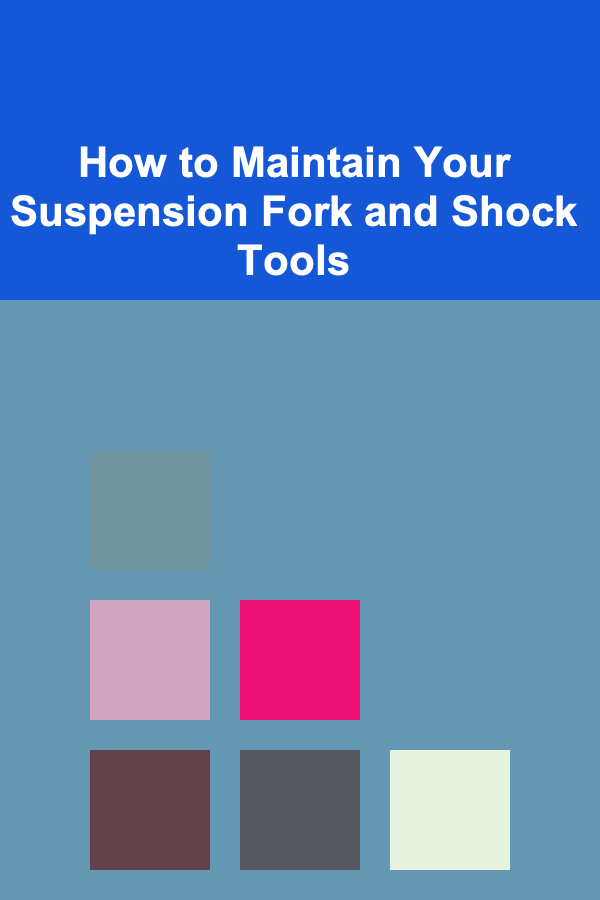
How to Maintain Your Suspension Fork and Shock Tools
ebook include PDF & Audio bundle (Micro Guide)
$12.99$11.99
Limited Time Offer! Order within the next:

Introduction: The Foundation of Suspension Service
Maintaining your suspension fork and shock is crucial for optimal performance, safety, and longevity of your mountain bike. But equally important, and often overlooked, is the maintenance of the tools you use to service these components. Properly cared for tools ensure efficient, accurate, and damage-free service, ultimately saving you time, money, and frustration. Neglecting your tools can lead to stripped bolts, damaged seals, and inaccurate torque readings, potentially causing serious problems with your suspension system.
This comprehensive guide will delve into the essential aspects of maintaining your suspension fork and shock service tools, covering everything from cleaning and storage to calibration and repair. We'll explore different tool types, materials, and common issues, providing practical tips and best practices to keep your tools in top condition for years to come.
Why Tool Maintenance Matters: Beyond the Obvious
The reasons for maintaining your suspension tools extend beyond simply keeping them clean. Consider these crucial aspects:
- Accuracy: Torque wrenches, seal presses, and even simple measuring tools like calipers lose accuracy over time due to wear and tear, improper storage, and lack of calibration. Inaccurate torque can lead to over-tightened bolts, damaging threads or preload systems, or under-tightened bolts, resulting in loose components and potential failure. Incorrect seal installation can cause leaks and premature wear.
- Efficiency: Clean and well-maintained tools are simply easier and faster to use. Sticky sockets, dull blades, and corroded threads slow down the service process and increase the risk of mistakes.
- Safety: A broken or damaged tool can be dangerous, potentially causing injury to yourself or damage to your bike. Imagine a stripped socket slipping while tightening a critical bolt on your fork!
- Prevention of Damage: Using the wrong tool or a damaged tool can easily damage your suspension components. Stripped bolts, scratched stanchions, and torn seals are common consequences of using poorly maintained tools.
- Longevity of Tools: Proper care significantly extends the lifespan of your tools. Investing time in maintenance protects your initial investment and prevents the need for frequent replacements.
- Professionalism: Even if you're only servicing your own bike, using well-maintained tools demonstrates professionalism and attention to detail, leading to better results and greater confidence in your work.
Think of your suspension tools as an investment in your bike's performance and your own safety. Treat them with the same care and attention you give to your suspension components themselves.
Essential Suspension Tool Categories and Maintenance
Suspension service requires a variety of specialized tools. Understanding the specific needs of each category is essential for effective maintenance.
1. Torque Wrenches: The Precision Instrument
Torque wrenches are arguably the most critical tools for suspension service. They ensure that bolts are tightened to the manufacturer's specified torque, preventing damage and ensuring proper function.
- Types: Click-type, beam-type, and digital torque wrenches. Click-type are most common for their ease of use, while digital offer the highest accuracy and features. Beam-type are simple and durable, but require careful visual reading.
- Maintenance:
- Cleaning: Wipe down the wrench after each use to remove grease, oil, and dirt. Use a clean rag and a mild degreaser if necessary.
- Storage: Store the torque wrench in its case or a protected environment when not in use. Never store a click-type torque wrench with the setting at its maximum. Always dial it back to the lowest setting on the scale to release the spring tension.
- Calibration: Torque wrenches should be calibrated periodically, typically every year or two, depending on frequency of use. Calibration services are offered by many tool suppliers or specialized calibration labs. A poorly calibrated torque wrench can cause serious damage and is worse than not using a torque wrench at all.
- Inspection: Regularly inspect the wrench for signs of damage, such as cracks, loose parts, or a sticky mechanism.
- Repair: If you suspect your torque wrench is malfunctioning, do not attempt to repair it yourself unless you are qualified. Send it to a professional for repair or calibration.
- Battery Care (for Digital Wrenches): Replace batteries promptly when they are low to ensure accurate readings. Remove batteries when storing the wrench for extended periods to prevent corrosion.
- Common Problems:
- Click-type: Inaccurate click, slipping mechanism, broken adjustment knob.
- Beam-type: Bent pointer, damaged scale.
- Digital: Faulty display, inaccurate readings, battery issues.
Tip: Always use the correct socket size and type for the bolt you are tightening. Using an incorrect socket can damage the bolt head and the socket itself, leading to inaccurate torque readings.
2. Shock Pumps: The Pressure Gauge
Shock pumps are used to inflate air springs in forks and shocks to the correct pressure. Accuracy is crucial for proper suspension setup.
- Types: Standard shock pumps with analog or digital gauges, high-volume pumps for coil shocks.
- Maintenance:
- Cleaning: Wipe down the pump after each use to remove dirt and debris. Pay particular attention to the valve head.
- Storage: Store the pump in a clean and dry place.
- Gauge Calibration: Compare your shock pump reading with a known accurate pressure gauge (e.g., a digital tire pressure gauge) periodically. If there is a significant discrepancy, consider replacing the pump or having it calibrated professionally.
- Seal Inspection: Inspect the seals in the pump head regularly for wear or damage. Replace them as needed.
- Hose Inspection: Check the hose for cracks, kinks, or leaks. Replace the hose if necessary.
- Common Problems:
- Inaccurate gauge: Leads to incorrect suspension pressure.
- Leaky valve head: Results in pressure loss during inflation.
- Damaged hose: Prevents proper inflation.
Warning: Never over-inflate your suspension. Always follow the manufacturer's recommended pressure ranges. Over-inflation can damage the suspension components and potentially cause serious injury.
3. Seal Drivers/Presses: The Gentle Touch
Seal drivers and presses are used to install seals and bushings in forks and shocks without damaging them. Proper alignment and even pressure are essential.
- Types: Universal seal drivers, specific-size seal presses, bushing installation tools.
- Maintenance:
- Cleaning: Clean the tools thoroughly after each use to remove grease, oil, and dirt. Use a solvent or degreaser to remove stubborn residue.
- Storage: Store the tools in a protective case or drawer to prevent damage.
- Surface Inspection: Inspect the surfaces of the drivers and presses for any burrs, scratches, or dents. These imperfections can damage the seals during installation. Deburr or smooth any imperfections with fine sandpaper or a file.
- Thread Lubrication: Lubricate the threads of seal presses with a light grease or anti-seize compound to ensure smooth operation and prevent seizing.
- Alignment Check: Ensure that the seal drivers and presses are properly aligned before each use. Misalignment can cause damage to the seals and the suspension components.
- Common Problems:
- Damaged surfaces: Scratch seals during installation.
- Misalignment: Causes uneven seal installation.
- Stripped threads: Prevents proper tightening.
4. Vises: The Stable Foundation
A sturdy vise is essential for holding suspension components securely during service. Jaws should be protected to prevent damage to delicate parts.
- Types: Bench vises, soft-jaw vises, fork tube holding tools.
- Maintenance:
- Cleaning: Clean the vise regularly to remove grease, oil, and dirt.
- Jaw Protection: Use soft jaws (made of aluminum, copper, or plastic) to protect delicate suspension components from damage. Replace soft jaws when they become worn or damaged.
- Lubrication: Lubricate the vise screw and sliding parts with a light oil or grease to ensure smooth operation.
- Tightening Adjustment: Check and adjust the vise tightening mechanism as needed to ensure a secure grip.
- Common Problems:
- Worn jaws: Can damage suspension components.
- Sticking screw: Makes it difficult to tighten or loosen the vise.
5. Sockets, Wrenches, and Hex Keys: The Basic Arsenal
A comprehensive set of sockets, wrenches, and hex keys (Allen wrenches) is essential for loosening and tightening various suspension components. Quality and fit are paramount.
- Types: Standard sockets and wrenches, deep sockets, Torx wrenches, hex keys (metric and imperial).
- Maintenance:
- Cleaning: Clean the tools after each use to remove grease, oil, and dirt.
- Storage: Store the tools in an organized manner to prevent damage and make them easy to find.
- Inspection: Inspect the tools regularly for signs of wear, such as rounded corners, cracks, or rust. Replace worn or damaged tools promptly.
- Rust Prevention: Apply a light coat of oil to the tools to prevent rust, especially in humid environments.
- Common Problems:
- Rounded corners: Can strip bolts.
- Rust: Makes the tools difficult to use.
- Cracks: Can cause the tools to break.
6. Measuring Tools: The Precise Dimension
Calipers, rulers, and feeler gauges are used to measure suspension components accurately, ensuring proper clearances and tolerances.
- Types: Digital calipers, dial calipers, rulers, feeler gauges.
- Maintenance:
- Cleaning: Clean the measuring tools after each use to remove grease, oil, and dirt.
- Storage: Store the tools in a protective case or drawer to prevent damage.
- Calibration: Calibrate the calipers and rulers periodically to ensure accuracy. Use gauge blocks or other known standards for calibration.
- Battery Replacement (for Digital Calipers): Replace batteries promptly when they are low to ensure accurate readings.
- Common Problems:
- Inaccurate readings: Leads to incorrect measurements.
- Damaged jaws: Affects measurement accuracy.
- Battery issues (digital calipers): Causes inaccurate readings or display failure.
7. Specialized Tools: The Component Specific Helpers
Many suspension components require specialized tools for removal, installation, and adjustment. These tools are often specific to a particular brand or model.
- Examples: Damper removal tools, air spring adapters, rebound adjuster tools, bushing removal tools.
- Maintenance:
- Cleaning: Clean the tools after each use to remove grease, oil, and dirt.
- Storage: Store the tools in a protective case or drawer to prevent damage.
- Instruction Manuals: Keep the instruction manuals for these tools readily available for reference.
- Component Compatibility: Ensure that the specialized tools are compatible with the specific suspension components you are servicing. Using the wrong tool can cause damage.
- Common Problems:
- Bent or broken parts: Can make the tools unusable.
- Stripped threads: Prevents proper tightening.
- Incompatibility: Can damage suspension components.
Best Practices for Tool Storage
Proper storage is crucial for protecting your suspension tools from damage and ensuring their longevity. Consider these best practices:
- Organized Storage: Use toolboxes, drawers, or wall-mounted racks to organize your tools. This makes it easier to find the right tool when you need it and prevents tools from being lost or damaged.
- Protective Cases: Store delicate tools, such as torque wrenches and measuring instruments, in their protective cases when not in use.
- Clean and Dry Environment: Store your tools in a clean and dry environment to prevent rust and corrosion.
- Temperature Control: Avoid storing your tools in extreme temperatures, as this can damage sensitive components, such as torque wrenches and digital calipers.
- Labeling: Label your toolboxes and drawers clearly to make it easy to find the tools you need.
- Foam Inserts: Use foam inserts in your toolboxes to protect tools from damage and keep them organized.
- Regular Inventory: Take inventory of your tools periodically to ensure that nothing is missing or damaged.
Cleaning and Lubrication: Keeping Tools Functional
Regular cleaning and lubrication are essential for maintaining the functionality of your suspension tools.
- Cleaning Frequency: Clean your tools after each use to remove grease, oil, and dirt.
- Cleaning Methods: Use a clean rag, solvent, or degreaser to clean your tools. Avoid using abrasive cleaners, as these can damage the surfaces of the tools.
- Lubrication Frequency: Lubricate moving parts, such as vise screws and ratchet mechanisms, regularly to ensure smooth operation.
- Lubrication Types: Use a light oil or grease to lubricate your tools. Avoid using heavy greases, as these can attract dirt and debris.
- Rust Prevention: Apply a light coat of oil to your tools to prevent rust, especially in humid environments.
Repairing Damaged Tools: When to DIY and When to Call a Pro
Minor tool repairs can often be performed at home, but more complex repairs should be left to professionals.
- DIY Repairs:
- Replacing worn sockets or wrenches.
- Tightening loose screws or bolts.
- Sharpening dull blades (with appropriate safety precautions).
- Replacing batteries in digital calipers.
- Replacing seals in shock pumps.
- Professional Repairs:
- Calibrating torque wrenches.
- Repairing damaged torque wrench mechanisms.
- Repairing damaged seal presses or drivers.
- Repairing complex vise mechanisms.
Warning: Always use caution when repairing tools. Wear appropriate safety gear, such as eye protection and gloves. If you are not comfortable performing a repair, it is best to seek professional assistance.
Investing in Quality Tools: A Long-Term Perspective
While it can be tempting to save money by purchasing cheaper tools, investing in quality tools is a smart long-term strategy. Quality tools are more durable, accurate, and reliable, and they will ultimately save you time, money, and frustration.
- Durability: Quality tools are made from high-quality materials and are designed to withstand the rigors of regular use.
- Accuracy: Quality tools are manufactured to tighter tolerances, ensuring accurate measurements and torque readings.
- Reliability: Quality tools are less likely to break or malfunction, reducing downtime and preventing damage to your suspension components.
- Ergonomics: Quality tools are often designed with ergonomics in mind, making them more comfortable and easier to use.
- Warranty: Quality tools often come with a warranty, providing peace of mind in case of defects or malfunctions.
Consider purchasing tools from reputable brands that are known for their quality and reliability. Research reviews and compare prices before making a purchase. Don't be afraid to invest in tools that will last for years to come.
Specific Tool Maintenance Checklist
Here's a concise checklist to guide your regular tool maintenance routine:
- After Each Use:
- Clean tools with a rag to remove grease, oil, and dirt.
- Store tools in their designated locations.
- Monthly:
- Inspect tools for signs of wear or damage.
- Lubricate moving parts.
- Check the calibration of measuring tools.
- Annually:
- Calibrate torque wrenches.
- Replace worn seals in shock pumps.
- Deep clean tools.
- Take inventory of tools.
Conclusion: The Rewards of Diligent Tool Care
Maintaining your suspension fork and shock service tools is an investment that pays dividends in the form of improved efficiency, accuracy, safety, and tool longevity. By following the guidelines and best practices outlined in this guide, you can ensure that your tools are always ready to perform their best, enabling you to service your suspension components with confidence and achieve optimal performance on the trail. Remember that your tools are an extension of your skill and dedication to your sport. Take care of them, and they will take care of you and your bike.

How to Market Your Meeting Planning Services to Corporate Clients: An Actionable Guide
Read More
How to Stay Safe During Power Outages with Backup Security Systems
Read More
How To Use Krita for Digital Art and Painting
Read More
How to Master Scalping Strategies
Read More
How to Develop Early Cultural Awareness
Read More
How to Visit Indigenous Communities Respectfully
Read MoreOther Products

How to Market Your Meeting Planning Services to Corporate Clients: An Actionable Guide
Read More
How to Stay Safe During Power Outages with Backup Security Systems
Read More
How To Use Krita for Digital Art and Painting
Read More
How to Master Scalping Strategies
Read More
How to Develop Early Cultural Awareness
Read More